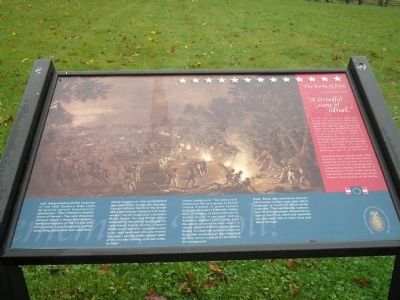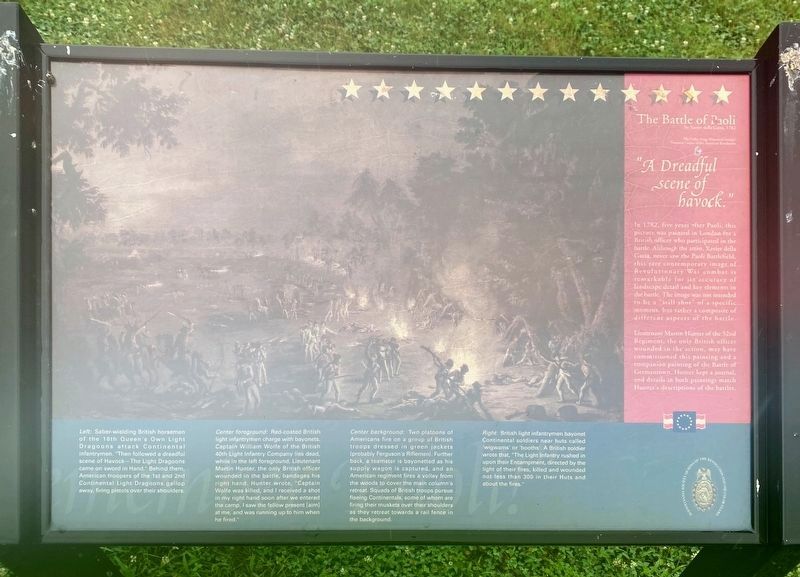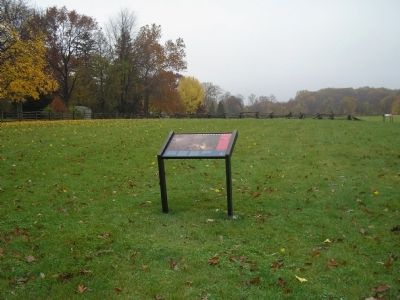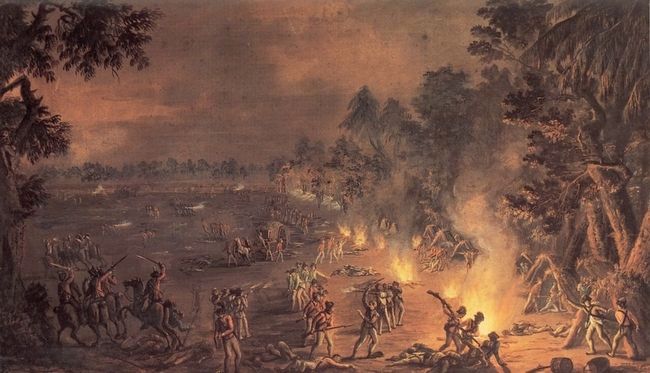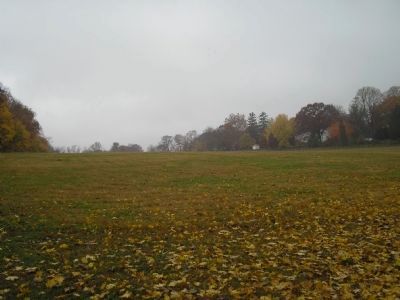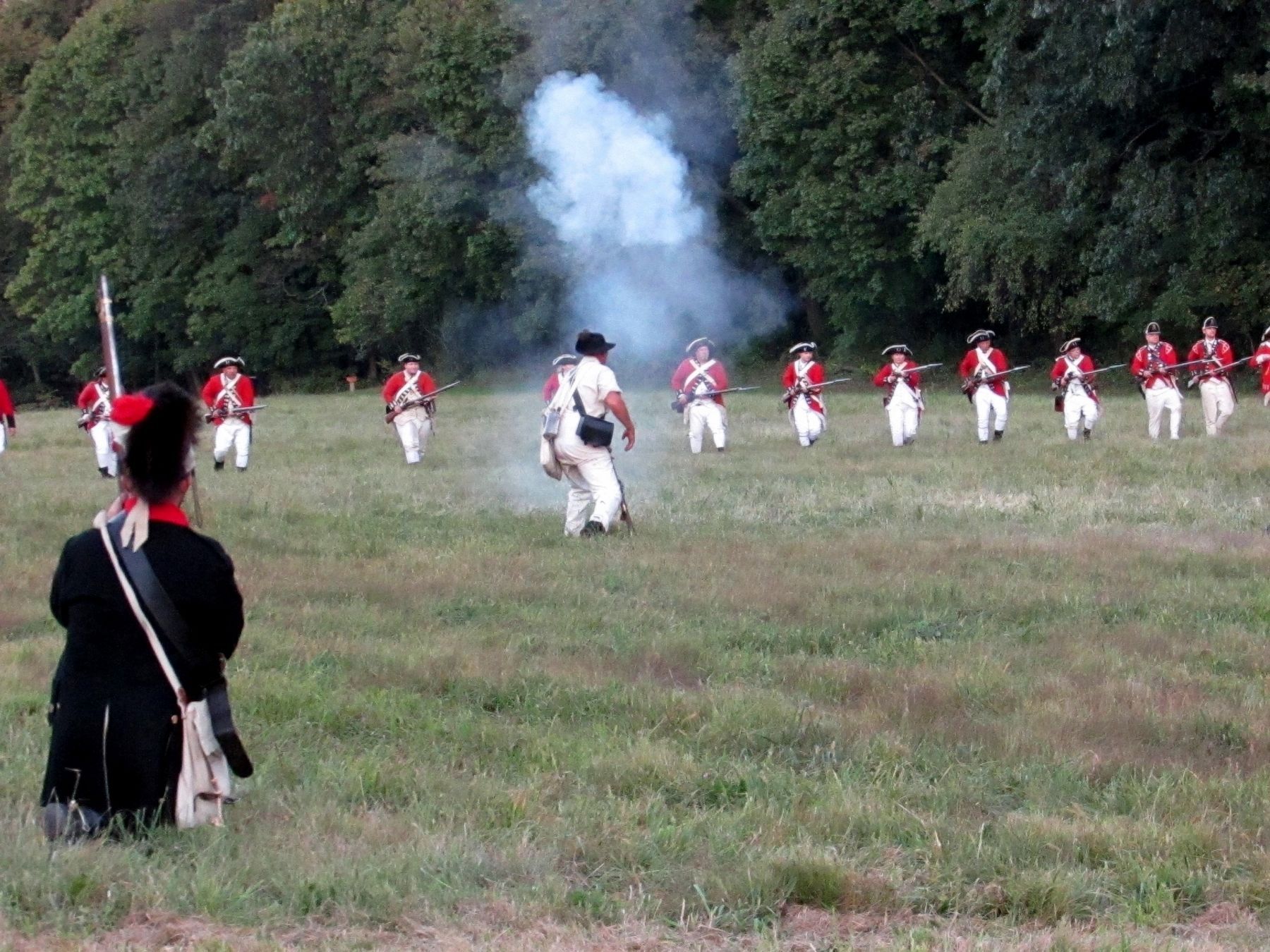Malvern in Chester County, Pennsylvania — The American Northeast (Mid-Atlantic)
“A Dreadful scene of havock”
Lieutenant Martin Hunter of the 52nd Regiment, the only British officer wounded in the action, may have commissioned this painting and a companion painting of the Battle of Germantown. Hunter kept a journal, and details in both paintings match Hunter’s descriptions of the battles.
Topics. This historical marker is listed in these topic lists: Notable Events • Notable Places • War, US Revolutionary. A significant historical year for this entry is 1782.
Location. 40° 1.804′ N, 75° 31.074′ W. Marker is in Malvern, Pennsylvania, in Chester County. Marker is on Monument Avenue, on the left when traveling west. Marker is on the Paoli Battlefield. Touch for map. Marker is in this post office area: Malvern PA 19355, United States of America. Touch for directions.
Other nearby markers. At least 8 other markers are within walking distance of this marker. General Wayne’s Encampment (within shouting distance of this marker); "…The most dreadful scene I have ever beheld." (within shouting distance of this marker); The Paoli Battlefield (within shouting distance of this marker); "Losing a wheel and crashing into a gap in the fence line"... (within shouting distance of this marker); Battlefield Site Map (within shouting distance of this marker); This Wall (within shouting distance of this marker); Paoli Massacre Monument (within shouting distance of this marker); "We bury’d our Dead next day in the field of Battle, All kill’d by the sword and Bayonet." (about 300 feet away, measured in a direct line). Touch for a list and map of all markers in Malvern.
More about this marker. The marker is dominated by the painting of “The Battle of Paoli” by Xavier della Gatta, 1782 courtesy of The Valley Forge Historical Society. It has the following captions:
‘Left: Saber-wielding British horsemen of the 16th Queen’s Own Light Dragoons attack Continental infantrymen. “Then followed a dreadful scene of Havock – The Light Dragoons came on sword in Hand.” Behind them, American troopers of the 1st and 2nd Continental Light Dragoons gallop away, firing pistols over their shoulders.’
‘Center foreground: Red-coated British light infantrymen charge with bayonets. Captain William Wolfe of the British 40th Light Infantry Company lies dead, while in the left foreground, Lieutenant Martin Hunter, the only British officer wounded in the battle, bandages his right hand. Hunter wrote, “Captain Wolfe was killed, and I received a shot in my right hand soon after we entered the camp. I saw the fellow present [aim] at me, and was running up to him when he fired.”’
‘Center background: Two platoons of Americans fire on a group of British troops dressed in green jackets (probably Ferguson’s Riflemen). Further back, a teamster is bayoneted as his supply wagon is captured, and an American regiment fires a volley from the woods to cover the main column’s retreat. Squads of British troops pursue fleeing Continentals, some of whom are firing their muskets over their shoulders as they retreat towards a rail fence in the background.’
‘Right: British light infantrymen bayonet Continental soldiers near huts called “wigwams” or “booths”. A British soldier wrote that, “The Light Infantry rushed in upon their Encampment, directed by the light of their fires, killed and wounded not less than 300 in their Huts and about the fires.”’
Related markers. Click here for a list of markers that are related to this marker. This series of markers follow the walking trail of the Paoli Battlefield.
Also see . . .
1. The Battle of Paoli, Xavier della Gatta. A copy of “The Battle of Paoli” painting on the ExplorePAhistory.com website. (Submitted on November 11, 2008, by Bill Coughlin of Woodland Park, New Jersey.)
2. The Battle of Paoli (Massacre) September 21, 1777 at Malvern, Pennsylvania. The American Revolutionary War website. (Submitted on November 11, 2008, by Bill Coughlin of Woodland Park, New Jersey.)
3. The Battle of Paoli also known as the Paoli Massacre. A British perspective of the battle from BritishBattles.com (Submitted on November 11, 2008, by Bill Coughlin of Woodland Park, New Jersey.)
Credits. This page was last revised on May 19, 2021. It was originally submitted on November 11, 2008, by Bill Coughlin of Woodland Park, New Jersey. This page has been viewed 1,471 times since then and 25 times this year. Photos: 1. submitted on November 11, 2008, by Bill Coughlin of Woodland Park, New Jersey. 2. submitted on May 12, 2021, by Shane Oliver of Richmond, Virginia. 3. submitted on November 11, 2008, by Bill Coughlin of Woodland Park, New Jersey. 4. submitted on September 19, 2015, by J. J. Prats of Powell, Ohio. 5. submitted on November 11, 2008, by Bill Coughlin of Woodland Park, New Jersey. 6. submitted on September 24, 2017, by Bill Coughlin of Woodland Park, New Jersey.
